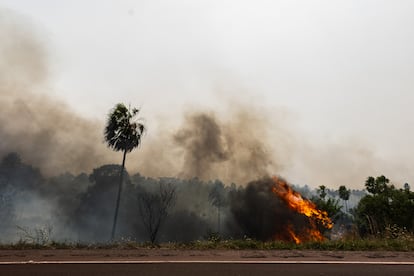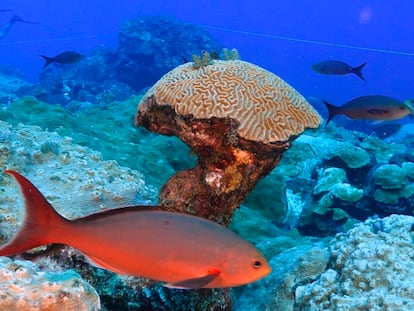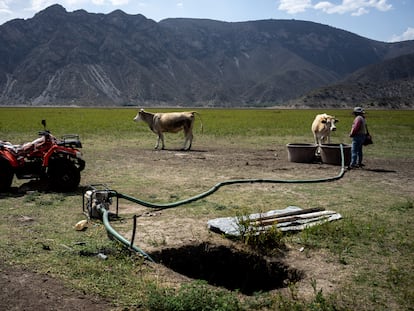Fire devours Brazil’s Pantanal, the largest jaguar refuge in the world
The blazes in this wetland on the border with Bolivia and Paraguay are breaking records in November, when the rainy season should have already begun

Half of the world’s jaguars live in Brazil, and most of them are concentrated in the Pantanal, a gigantic wetland on the border with Bolivia and Paraguay. In recent days, fires have been devouring the home of this feline, triggering an environmental tragedy that is repeated every year in the dry season, but which is now breaking records due to a longer-than-usual drought and the effects of El Niño, which has caused a historic heat wave in Brazil. In the first half of November, more than 3,000 blazes were detected, the worst figure in 21 years, according to the National Institute for Space Research (Inpe), which captures satellite images.
The Pantanal is the largest floodplain in the world, but its landscape changes radically over the months. Fire appears every year, but normally the peak occurs between August and September, at the height of the dry season. The rainy season should have started in November. That is when the long-suffering vegetation gets a respite and begins to turn green, when the lagoons, dry for months, begin to fill up. However, this month there are more fires than ever.
Many of these fires are started intentionally to make room for livestock and agriculture (especially soybeans, as this region is Brazil’s breadbasket), but there is also a natural factor. The storms these days are barely releasing water, but they bring with them lightning that, upon hitting the dry ground, makes everything burn very easily. So far this year, more than one million hectares of the Pantanal have been consumed by flames, three times more than in all of 2022. It is an area equivalent to more than 16 times the city of Madrid or 6.5 times São Paulo.
This wetland has been burning uninterruptedly for almost a month, but in recent days there has been a leap in scale: the flames have reached the Transpantaneira, the 150-kilometer highway that acts as the spine around which the majority of farms that make a living out of ecotourism are located. At one end of this road is the city of Porto Jofre, which in recent years has been gaining a reputation as one of the best jaguar-watching spots in Brazil. Most of these felines live in the Amazon rainforest, but the density of the vegetation makes it almost impossible to spot them. In the Pantanal, on the other hand, with a landscape more similar to that of the African savanna, it is easier. In Porto Jofre alone, specialists have already cataloged more than 300 animals, one of the highest densities on the planet. There are so many that specialized travel agencies even offer tourists the chance to name the unidentified ones. In this city, photographic safaris already represent a $10 million-a-year business, and have helped increase the supply of beds by 40% compared to the pre-pandemic period, according to data from the Federal University of Mato Grosso and the NGO Panthera.
But now, fire is threatening this incipient modality of sustainable development. The Foundo das Águas Natural Park, one of the main refuges for the jaguar, has lost 36,000 hectares, or 34.7% of its surface area, due to the fires. It is not the only reservation that’s been affected: 19% of the neighboring Pantanal Matogrossense National Park, with an even higher level of protection, has also been completely razed, and half of the territory of the Tereza Cristina indigenous land, where more than 500 Bororo indigenous people live, is now a wasteland of gray ash.
Dozens of volunteers are racing to rescue as many animals as possible, although access is complicated and the overall scenario is devastating, as veterinarian Anderson Fernandes Barreto explained to the G1 website. “The Pantanal was a biome with many animals, but today we reach those points and it is already difficult to find any live animals. Unfortunately what we are experiencing here is an open-air cemetery. The fauna and flora are paying with their lives the price of the recklessness of human beings,” he lamented. The Pantanal has been a Biosphere Reserve and a UNESCO World Heritage Site for two decades.
The states of Mato Grosso and Mato Grosso do Sul, which share the biome, have declared a state of emergency and now firefighters are focusing mainly on safeguarding the homes located around the Transpantaneira. Some pousadas have already begun to be evacuated. The central government, which months ago launched the “Pantanal without fires” campaign to extend prevention action among the local population, has so far mobilized 256 firefighting brigade members and four helicopters. It is also evaluating the participation of the army in the tasks of fighting the flames.
Sign up for our weekly newsletter to get more English-language news coverage from EL PAÍS USA Edition
Tu suscripción se está usando en otro dispositivo
¿Quieres añadir otro usuario a tu suscripción?
Si continúas leyendo en este dispositivo, no se podrá leer en el otro.
FlechaTu suscripción se está usando en otro dispositivo y solo puedes acceder a EL PAÍS desde un dispositivo a la vez.
Si quieres compartir tu cuenta, cambia tu suscripción a la modalidad Premium, así podrás añadir otro usuario. Cada uno accederá con su propia cuenta de email, lo que os permitirá personalizar vuestra experiencia en EL PAÍS.
¿Tienes una suscripción de empresa? Accede aquí para contratar más cuentas.
En el caso de no saber quién está usando tu cuenta, te recomendamos cambiar tu contraseña aquí.
Si decides continuar compartiendo tu cuenta, este mensaje se mostrará en tu dispositivo y en el de la otra persona que está usando tu cuenta de forma indefinida, afectando a tu experiencia de lectura. Puedes consultar aquí los términos y condiciones de la suscripción digital.
More information
Archived In
Últimas noticias
Most viewed
- Reinhard Genzel, Nobel laureate in physics: ‘One-minute videos will never give you the truth’
- Oona Chaplin: ‘I told James Cameron that I was living in a treehouse and starting a permaculture project with a friend’
- Pablo Escobar’s hippos: A serious environmental problem, 40 years on
- Charles Dubouloz, mountaineering star, retires at 36 with a farewell tour inspired by Walter Bonatti
- Why we lost the habit of sleeping in two segments and how that changed our sense of time










































